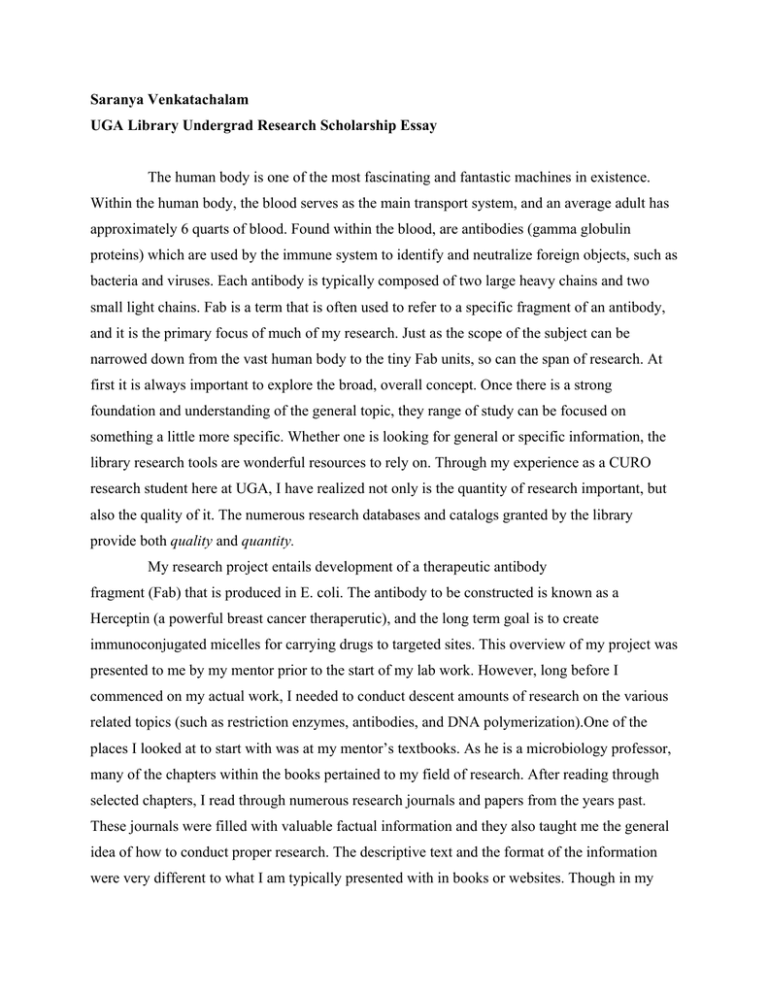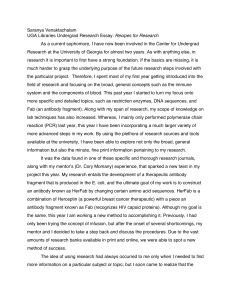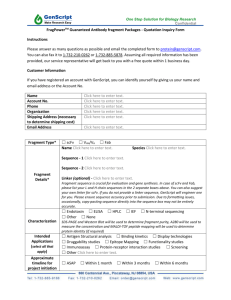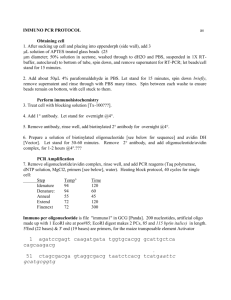Saranya Venkatachalam UGA Library Undergrad Research Scholarship Essay
advertisement

Saranya Venkatachalam UGA Library Undergrad Research Scholarship Essay The human body is one of the most fascinating and fantastic machines in existence. Within the human body, the blood serves as the main transport system, and an average adult has approximately 6 quarts of blood. Found within the blood, are antibodies (gamma globulin proteins) which are used by the immune system to identify and neutralize foreign objects, such as bacteria and viruses. Each antibody is typically composed of two large heavy chains and two small light chains. Fab is a term that is often used to refer to a specific fragment of an antibody, and it is the primary focus of much of my research. Just as the scope of the subject can be narrowed down from the vast human body to the tiny Fab units, so can the span of research. At first it is always important to explore the broad, overall concept. Once there is a strong foundation and understanding of the general topic, they range of study can be focused on something a little more specific. Whether one is looking for general or specific information, the library research tools are wonderful resources to rely on. Through my experience as a CURO research student here at UGA, I have realized not only is the quantity of research important, but also the quality of it. The numerous research databases and catalogs granted by the library provide both quality and quantity. My research project entails development of a therapeutic antibody fragment (Fab) that is produced in E. coli. The antibody to be constructed is known as a Herceptin (a powerful breast cancer theraperutic), and the long term goal is to create immunoconjugated micelles for carrying drugs to targeted sites. This overview of my project was presented to me by my mentor prior to the start of my lab work. However, long before I commenced on my actual work, I needed to conduct descent amounts of research on the various related topics (such as restriction enzymes, antibodies, and DNA polymerization).One of the places I looked at to start with was at my mentor’s textbooks. As he is a microbiology professor, many of the chapters within the books pertained to my field of research. After reading through selected chapters, I read through numerous research journals and papers from the years past. These journals were filled with valuable factual information and they also taught me the general idea of how to conduct proper research. The descriptive text and the format of the information were very different to what I am typically presented with in books or websites. Though in my professor’s lab library there were only a selected number of journals (in hardcopy), after a quick trip to the reference library in the UGA student learning center, I was able to get immediate access to wide variety of research articles using EJL journals and numerous other programs. While studying the articles, I realized that just like with any other source of literature, the date of the research findings and the journal publication is actually very crucial. After all, researched information is susceptible to change. After gathering notes from various outside sources and talking to my professor in detail about the project, I read through one of the Promega Corporation resource books. Promega is one of the major companies in applying biochemistry and molecular biology to the development of new lab techniques, and it is where most of the microbiology lab materials were purchased from. The Promega book is essentially like the all time encyclopedia for quick lab references I soon became friends with the librarians at third floor reference library who gave me plenty of useful information. Previously, I had only used Google to search for anything and everything. I soon realized that within the Google search engine, there is a specified service called Google Scholar. Whereas ordinary Google searches throw out 1000s of websites, Google Scholar presents a much more dependable and concise list. Unlike various other sources, Google Scholar can be accessed easily from places away from campus and it does not require login information. Apart from Google, the other major sources I was familiar with were the extensive online databases, Galileo and the Academic Search Premier. After navigating through all the application tools, I noticed that there are even better places for my research. One of these places is Web of Science, the world's leading citation database. During my search on Herceptin Fab fragments using Web of Science, I ran into a very interesting link that pulled up previous science conference proceedings! It is incredibly easy to research using this database, because it allows the researcher to identify citation patterns and core publications. This facility to backtrack material is much more effective then having to repeatedly perform new searches; it not only saves time, but also provides more directly related information. Similar to Web of Science, I was highly drawn into Medline and Pubmed. Through Pubmed, one can explore their particular search by quickly finding other papers written by the same author. This tool can come in handy, and easily expand one’s collection of information. Like the other source, both Medline and Pubmed have a vast collection of full test articles. From PubMed, I was able to branch off and locate PubMed Central. PMC is essentially a free digital archive of biomedical life science journal literature. I was very lucky to fall upon this archive because I tend to be a visual learner, and complicated concepts (hemolysis assays, protein purification, etc) can be made much clearer through images/videos. In addition, PMC contained full author manuscripts for further information. After researching the topic, the next step is to outline the procedures of the research experiment. Based on the formulated plan, one of the first lab assignments was to conduct a PCR (polymerization chain reaction). As I embarked on my first lab activity, I realized that relying on a protocol manual alone is not enough. Though the manual I was given helped me determine how much of the components I needed and how to properly address all the necessary steps to a PCR reaction, it was not the best source to rely on for conceptualization. Therefore, in addition to the manual, I looked up several online sources (IPA Research Foundation and Science Encyclopedia articles) that provided me with more specific information along with the visual images of a PCR process. As I was working on my first lab activity, I realized that not is it important to do a certain task correctly, it is also important to know why that step has to be done. For instance, a PCR reaction is done mainly for the purpose of making a huge number of copies of a genes and ensuring there is enough starting template for sequencing. Additionally, throughout my PCR work, I learned a plethora of general lab techniques and safety precautions, particularly those pertaining to molecular biology. It took me several PCR runs before I was able to finally run a gel that worked; however, I realize that with research comes patience and time. It is not something that can be rushed, especially when transferring quantities of 1 microliter! Furthermore, every step of research teaches something even if the experiment fails. In general, though research takes highly meticulous and time-consuming work, when it does produce successful results, it is very rewarding. However, research is not always just about making spectacular discoveries, but more so about the actual learning process that goes into it. After the completing the sets of PCR reaction, I was ready to move to gel purification and in the fusion stage of my project. As this was a new task, prior to the actual implementation of the experiment, a general protocol and background information had to be researched. I collected relevant background information through numerous articles from Science Direct and recorded my notes in my lab notebook. After several weeks in a research lab environment, I realized that taking notes is definitely worth the time. Not only is it crucial to take down notes on the physical procedures, but also on the concept itself. Science Direct had numerous sub- databases that included a link to articles from journals (ProQuest) and from encyclopedias (Encyclopedia Britannica). Within ProQuest, I was able to even able to select a category as specific as ‘Cell Bioloy’ and search only within that field. In addition, all of the Science Direct articles had informative abstracts and outlines. The outlines were very useful for navigation purposes especially in long articles. As far as searching for the actual protocol, my mentor was my primary source. He gave me a general outline of everything that was involved in a particular step; however, it is also helpful to refer to a lab manual. As the lab did not have a hardcopy manual for every task, I had to search online for certain instruction sets. As I hunted for protocols online, I realized that choosing the correct search engine alone is not enough. It is also necessary to have proper search strategies. When I searched from instruction protocols, I typically included the name of the biological company that supplied the materials as well as the words “how to”. For my future steps which include plasmid preparation and purification, protein purification, ELISA and hemolysis assays, and some cell culture (via collaborations), there is a provided manual that comes along with the materials from the biotech companies. Thus, when I researched those topics online, I tried to pick out keywords from the given manuals to include in my search. In addition, I used the hardcopy material from the biotech companies as a comparison to ensure the validity of online research findings. Other more general methods to search would be to pick out certain author/book names from the footnote of a specific article and incorporate it into a new search. On the whole, I feel search strategies are like chain growth reactions. One link can give information on how to find the next link and so on so forth. After finding the right sources and using efficient search strategies comes the question of how to compile one’s research. One of the best research organization tools available for undergrads is Endnote. Endnote can help tremendously with content organization and source citations. At first it was a bit confusing but after speaking with and emailing assistants in the science library and attending a RefWorks help session, I was able to get a much better understanding of its purpose. Both RefWorks and Endnotes are a great way to get a jump start on future research paper and thesis documents. Having the citation easily in store can be a good thing especially since I typically find myself wanting to re-visit a specific webpage or article. Though I am not currently working on composing my own research paper, I believe it will be a good habit for me to go ahead and start using these sources. Moreover, as an additional convenience, many of the library database allow for the articles to be directly emailed and stored for future purposes. In particular, Web of Science shows the number of previous citations and other relevant information that can further enhance the process of individual research. Furthermore, the digital library in the student learning center is a unique facility that enhances one’s research career. In the near future, I, along with the rest of the students in my professor’s lab intend on having a video conference regarding out research progress and findings. My professor has a connection with a team in Saudi Arabia, and hopefully, we will soon be able to view labs that are located around the globe. The digital media library is by far not the only unique feature of the UGA libraries. Other great services include the GIL express request and the Interdisciplinary Library Loan (IILIAD). Both the catalogs allow UGA students to obtain items that are currently held throughout the state. Even more useful to research is the ‘find it at UGA’ option found in many of the specific links. This tool can pinpoint the location of the material and with some librarian’s assistance the item can be found very quickly. I have asked numerous librarians (both in the science library and the main library) regarding the process of finding the correct source and getting my hands on it. Overall, from the time I have spent on my project thus far, I can safely say there is never a factor of ‘too much’ when it comes to research; in other one can never do ‘too much’ research. The amounts of information available and the amounts left to be discovered are essentially endless. Additionally, I strongly feel research will never to go to waste. Even at times when I have not found what I was looking for, I certainly came across new pieces of information and thus expanded my pool of knowledge. Throughout my first semester of research, I have come to develop a great appreciation for those who are actively involved in the research field, and I strive to be like them. Upon completing pharmacy school, and getting my Pharm D. I certainly plan on continuing research and earning a PhD as well. Most importantly, I feel the advantages of research help both the individual researcher as well as the general public. Especially in today’s society, research should be highly encouraged due to its role in the initiation of medical advances. Nevertheless, I have come to understand that research is definitely not confined to the subject of science alone! My CURO program has provided me with the wonderful opportunity to get first hand experience on the fundamentals of research and relevant lab work. I am really glad I chose to get involved in the CURO as a freshman, and I hope to pursue this endeavor throughout the remainder of my years at UGA as well as in my future profession. Saranya Venkatachalam ABSTRACT: The research project will entail development of a therapeutic antibody fragment (Fab) that is produced in E. coli. The student will evaluate whether antibodies produced using E. coli can be used as therapeutics. The critical issues that will be explored include demonstrating that proper folding of the antibody fragment occurs, appropriate antigen recognition is created, and that the Fab can be produced with adequately low contaminants (in particular, endotoxins) to be useful. The student will subclone gene fragments from the antigen binding loops of the trastuzumab antibody (HerceptinR) into a Fab-pET28b construct that expresses mouse Fab efficiently in E. coli to make "Her-Fab". The DNA sequences for making this construct have already been purchased and synthesized. The student will insert the mutant DNA (two sequences, one for the light chain, a second for the heavy chain), characterize the construct to confirm that the construct is correct, then express the Hercepin analogue in E. coli. After purifying the protein, the Fab will be evaluated for endotoxin contamination using an Endotoxin assay (Horseshoe Crab-based hemolysis assay). The purified protein will also be exposed to human cell lines that overexpress the HER2 receptor target of the antibody (Her2+ cells). In the presence of the purified Her-Fab, apoptosis should be induced. A positive control would be to introduce the authentic trastuzumab. Negative controls would include exposure to human Her2cells in culture. Overall, this experiment will provide functional understanding of the following techniques: PCR, cloning, plasmid preparation and purification, protein purification, ELISA and hemolysis assays, and some cell culture (via collaborations). Bibliography (in progress) Adams, A. and Pourahmad, F. “Comparative evaluation of Polymerase Chain Reaction–Restriction Enzyme Analysis (PRA).” Journal of Microbiological Methods, Feb 2009, Vol. 76 Issue 2, p128-135. Academic Search Premier. EBSCOhost. GALILEO. 1 Feb. 2009 <http://www.galileo.usg.edu>. Barker, Kathy. At the Bench: Laboratory Navigator. Upd.ed:2005. Chapters 1-9, 11- 12, 14-15. “Breast cancer: Herceptin target.” Nature. 13 Feb. 2003. Google Scholar. 5 Jan. 2008 <http://www.nature.com/nature/links/030213/030213-9.html>. Clonetech Laboratories. “In-fusion 2.0 CF Liquid PCR Cloning Kit User Manual.” California: Takara Bio, 17 March 2008. Park, Hong Keun. A vector for purification-free cloning of polymerase chain reaction products. Analytical Biochemistry, Jun2008, Vol. 377 Issue 1, p108-110. Academic Search Premier. EBSCOhost. GALILEO. 20 Nov. 2009 <http://www.galileo.usg.edu>. Punlap, Lloyd. “Automating Digital Pathology.” Drug Discovery News: The News and Business of Discovery Science. Jan. 07. PubMed Central. 21 Dec. 2008. <www.pubmedcentral.nih.gov/.>. Rozitah, R. “Detection of beta-globin gene mutations among Kelantan Malay thalassaemia patients by polymerase chain reaction restriction fragment length polymorphism”. Singapore Medical Journal. Dec 2008. Vol 49. Issue: 12. Pages: 1046-1049. Web of Science. <http://apps.isiknowledge.com. >. Rudolph and Sohn Jungsan. “Temperature dependence of binding and catalysis for the Cdc25B phosphatase.” Biological Chemistry. Vol. 25, Issue 2-3. November 2006. Science Direct. www.sciencedirect.com/science/journal/>. Sue, Pearson. “Therapeutic Cancer Vaccine Options.” The Genetic Engineering News. 1 Jan. 07: vol. 27. Pg 38. Zhong, X. “A human B cell Methylome at 100-base pair Resolution.” Proceedings of the National Academy of the Sciences. 20 Jan. 2009. Vol. 106. Issue: 3. Pages: 671-678. ISI Web of Knowledge-Web of Science <http://apps.isiknowledge.com.>. Saranya Venkatachalam ABSTRACT: The research project will entail development of a therapeutic antibody fragment (Fab) that is produced in E. coli. The student will evaluate whether antibodies produced using E. coli can be used as therapeutics. The critical issues that will be explored include demonstrating that proper folding of the antibody fragment occurs, appropriate antigen recognition is created, and that the Fab can be produced with adequately low contaminants (in particular, endotoxins) to be useful. The student will subclone gene fragments from the antigen binding loops of the trastuzumab antibody (HerceptinR) into a Fab-pET28b construct that expresses mouse Fab efficiently in E. coli to make "Her-Fab". The DNA sequences for making this construct have already been purchased and synthesized. The student will insert the mutant DNA (two sequences, one for the light chain, a second for the heavy chain), characterize the construct to confirm that the construct is correct, then express the Hercepin analogue in E. coli. After purifying the protein, the Fab will be evaluated for endotoxin contamination using an Endotoxin assay (Horseshoe Crab-based hemolysis assay). The purified protein will also be exposed to human cell lines that overexpress the HER2 receptor target of the antibody (Her2+ cells). In the presence of the purified Her-Fab, apoptosis should be induced. A positive control would be to introduce the authentic trastuzumab. Negative controls would include exposure to human Her2cells in culture. Overall, this experiment will provide functional understanding of the following techniques: PCR, cloning, plasmid preparation and purification, protein purification, ELISA and hemolysis assays, and some cell culture (via collaborations).





